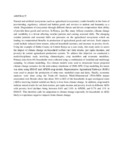| dc.description.abstract | Natural and artificial ecosystems (such as agricultural ecosystems), confer benefits in the form of provisioning, regulatory, cultural and habitat goods and services to nations and humanity as a whole. Degradation of ecosystems through different threats and drivers compromises their ability of provide these goods and services. In Kenya, just like many African countries, climate change and variability is a driver affecting weather patterns and causing seasonal shifts. The changing weather patterns and seasonal shifts are pressures on the agricultural ecosystems which are leading to compromised benefits in production of agricultural goods and services. Such impacts could include reduced farm returns, reduced household incomes, and increase in poverty levels. Using the example of Embu County in Central Kenya as a case study, this study seeks to assess the impact of climate change on household welfare (net farm returns, per capita incomes, and poverty) in current agricultural production systems. To address this objective we conducted a multi-disciplinary study involving climatologists, crop modellers and economic modellers. Primary data from 441 households were collected using a combination of stratified and multistage sampling. In climate modelling, five climate models were used to downscale future projected climate change scenarios for the mid-century timeframe of 2040-2070. Crop modelling for maize was done using DSSAT and APSIM crop models. Representative Agricultural Pathways (RAPs) were used to project the production of other non- modelled crops and dairy. Finally, economic analyses were done using the Trade-off Analysis Multi-Dimensional (TOA-MD) impact assessment tool. Results show that about 36% to 66% of the households in agro-ecological zones (AEZs) receiving limited rainfall are likely to lose from climate change. In addition, crop models indicate mixed results for net farm returns, per capita income and poverty levels in different AEZs with poverty level declines being between 0.6% and 3.8% in APSIM, and 0.7% and 11% in DSSAT. This therefore calls for adaptation to climate change especially for households in AEZs likely to experience negative impacts from climate change. | en_US |

